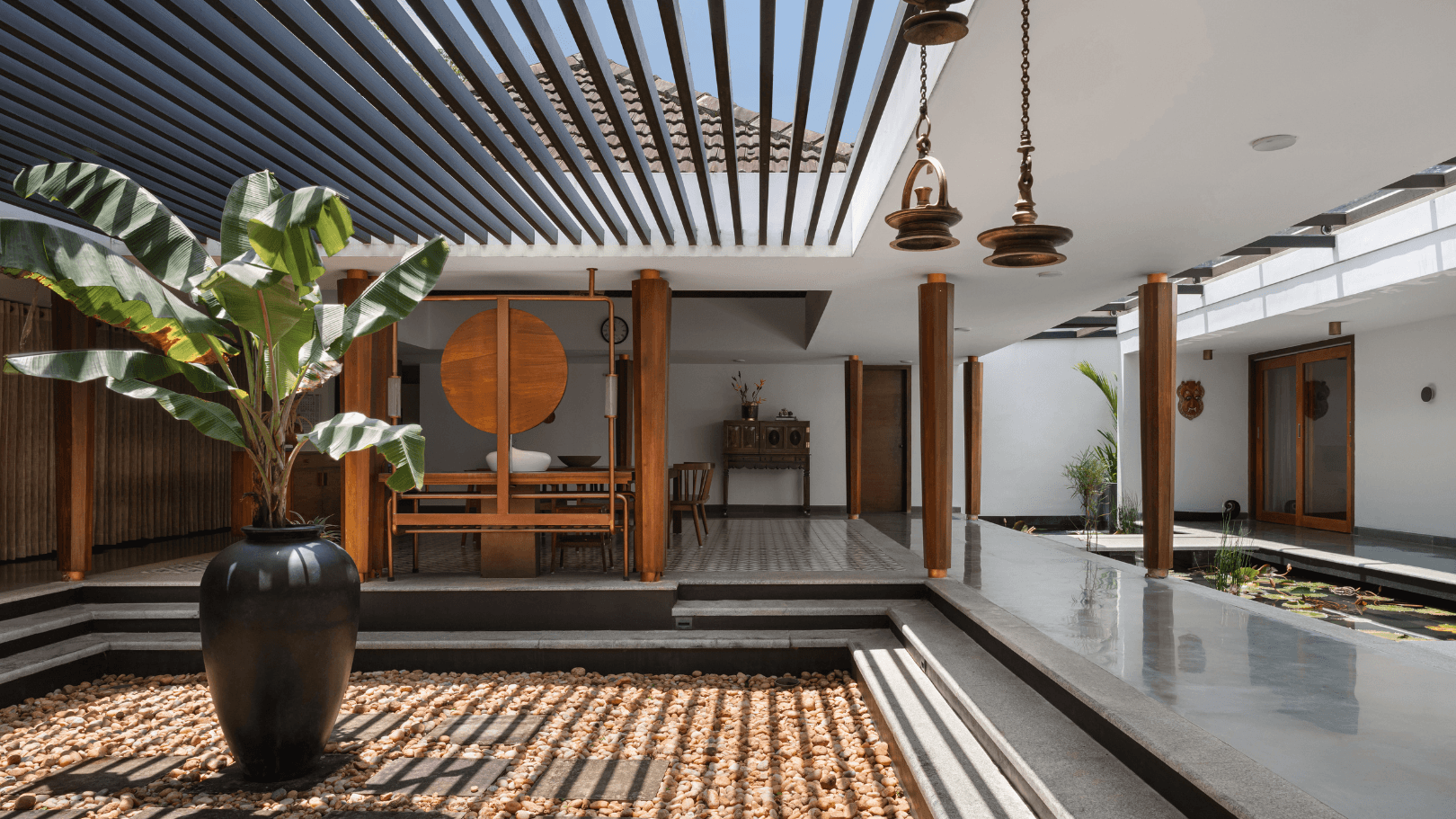Smart design ideas are a result of ingenuity and creativity. If you are someone who loves naturally lit spaces in your private residence, bookmark these AD-approved recommendations.
A Statement Skylight
Smaran Mallesh, principal architect at Cadence Architects, and his team designed this five-bedroom, 15,000-square-foot independent Karnataka home for a homeowner in the mining field. It reflects the client’s lavish lifestyle and has a living room, family space, kitchen, puja room, study area, and a powder room. The brief was to ensure that the home was Vastu-compliant, well-lit, and ventilated.
As Hospet has a hot climate throughout the year, the plan was designed in a manner that it blocks the sun in the west and the south. The home itself opens towards the garden in the north and the east. The traditional open-to-sky courtyard has been reinterpreted as a ‘landscape platform’ with an operable skylight. “The motorised glazing in the skylight can be opened to allow for the hot air to escape during the day. The muted finishes in the interiors further drape the architectural shell, accentuate the geometry, and render warmth to the space,” says Mallesh.
Original Text by Bindu Gopal Rao; Edited by Khushi Sheth.
Patterned Windows
For a California couple with two grown boys, Hawaii had always served as an escape. “We visited the islands dozens of times when our kids were growing up, and loved the warmth of the people, the nurturing, healing air, and the peace and tranquility,” says the wife. “We reached a point where we felt we wanted to grow roots here.” There was nothing exceptional about the site they ultimately chose: The landscape was barren but for a grove of kiawe trees and the faint underpinnings of a bygone building. But to the couple, it felt like a sign to stay.
The entry lanai, by way of its central placement, honors the principles of Vastu Shastra and represents the owners’ Indian heritage. The sun falls in slants over the seating area, which includes a custom upholstered bench, handwoven lounge chairs, and an Asturias rocking chair by Carlos Motta for Espasso. With slatted grills for walls and doors, an open air entry, and a Minka Aire Roto XL ceiling fan for warmer evenings, the space serves as a haven for both gathering and retreating. The pillow covers are Élitis, John Robshaw, Silkworks, and Bindi Gold designs.
Original Text by Vaishnavi Nayel Talawadekar; Edited by Khushi Sheth.
A Double Height Window
Secondary homes offer the perfect escape from the hustle of everyday life— serene, tranquil retreats that are designed to ease the mind and soothe the soul. This villa in Pune, is a prime example, a 4,000-square-foot sanctuary for a family of five—a young couple and their three children. Sahiba Madan of Insitu Design Studio took on the task of designing this home that fosters quality family time while also offering private retreats for individual moments of solitude.
The villa in Pune spans three floors, with shared spaces on the ground level and private bedrooms and areas situated on the upper floors. The ground floor features an entryway with a vaulted ceiling that seamlessly connects various areas of the home. To the left, an expansive double-height living room is complemented by a cosy reading nook nestled by the window. The mini library is framed by two towering bookshelves, complete with a ladder to access the upper shelves, while a daybed in the centre offers a comfortable spot to relax and unwind.
Original Text by Aishwarya Khurana; Edited by Khushi Sheth.
An Indoor Courtyard
For this home, architects Thomas Parambil and Ruben John Joseph's design ideas were straightforward: living doesn’t only happen in the living room, just like dining doesn’t just happen in the dining room. “Instead of boxing in these spaces, we designed a fluid, open-plan layout where each area flows naturally into the next, keeping the connection with nature intact,” Parambil explains. Nature was their guiding light—polished and raw stones were paired to mimic a rugged riverbed, and art was crafted from coconut leaves and other local treasures.
In Kerala’s hot and humid climate, creating a home in Kottayam that’s bright yet cool could be a tall order—but not for Parambil and Joseph. The duo conceived a central courtyard, an open nucleus connected by corridors and volumes throughout the home. “We designed it to maximise natural airflow and light,” Parambil shares. “The layout and room positioning were planned to keep it comfortable and eco-friendly year-round.” The architects consider the jali screen wrapping this Kerala home its crowning feature.
Original Text by Vaishnavi Nayel Talawadekar; Edited by Khushi Sheth.
An Arched Window
When a married couple with no kids—the husband’s parents—and occasionally sister moved into a 2,500-square-foot Delhi home in the city’s Vasant Vihar locality, they had all unanimously decided that they wanted it to look right out of Netflix’s Dream Home Makeover. Sanjana Mathur, the lead architect at Studio Bipolar, whose firm is located just a stone’s throw away from this apartment, tuned into the home renovation show for design inspiration as well. The project was christened Sunlit Serenity as every room of the sanctuary was an airy space filled with generous amounts of light.
The arched window in the hallway of this beautiful Delhi home was originally a tiny window that was opened up as that was the only space in the house with limited light. A very neutral, cool-toned marble runs across the floors to offset the warmer wooden tones that come up throughout the home. Sharp black accents cut through the space, the contrast is what makes this look work visually.
Original Text by Nolan Lewis; Edited by Khushi Sheth.

